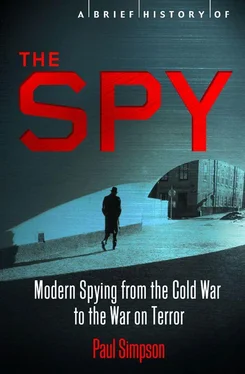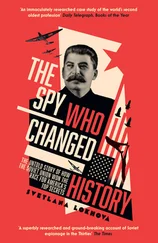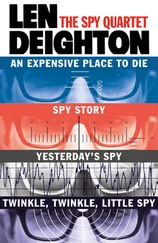Paul Simpson - A Brief History of the Spy
Здесь есть возможность читать онлайн «Paul Simpson - A Brief History of the Spy» весь текст электронной книги совершенно бесплатно (целиком полную версию без сокращений). В некоторых случаях можно слушать аудио, скачать через торрент в формате fb2 и присутствует краткое содержание. Город: London, Год выпуска: 2013, ISBN: 2013, Издательство: Constable & Robinson, Жанр: Прочая документальная литература, на английском языке. Описание произведения, (предисловие) а так же отзывы посетителей доступны на портале библиотеки ЛибКат.
- Название:A Brief History of the Spy
- Автор:
- Издательство:Constable & Robinson
- Жанр:
- Год:2013
- Город:London
- ISBN:9781780338910
- Рейтинг книги:3 / 5. Голосов: 1
-
Избранное:Добавить в избранное
- Отзывы:
-
Ваша оценка:
- 60
- 1
- 2
- 3
- 4
- 5
A Brief History of the Spy: краткое содержание, описание и аннотация
Предлагаем к чтению аннотацию, описание, краткое содержание или предисловие (зависит от того, что написал сам автор книги «A Brief History of the Spy»). Если вы не нашли необходимую информацию о книге — напишите в комментариях, мы постараемся отыскать её.
A Brief History of the Spy — читать онлайн бесплатно полную книгу (весь текст) целиком
Ниже представлен текст книги, разбитый по страницам. Система сохранения места последней прочитанной страницы, позволяет с удобством читать онлайн бесплатно книгу «A Brief History of the Spy», без необходимости каждый раз заново искать на чём Вы остановились. Поставьте закладку, и сможете в любой момент перейти на страницу, на которой закончили чтение.
Интервал:
Закладка:
We are accused of having been guided by a desire for vengeance. That is nonsense. What we did was to concretely prevent in the future. We acted against those who thought that they would continue to perpetrate acts of terror. I am not saying that those who were involved in Munich were not marked for death. They definitely deserved to die. But we were not dealing with the past; we concentrated on the future.
The PFLP’s final reported hijacking resulted in West German forces storming the plane when it was on the ground at Mogadishu airport in 1977. The British took similar strong action when terrorists seized hostages at the Iranian Embassy in London in April 1980. When a hostage’s body was pushed through the front door after the terrorists lost patience with the authorities, Prime Minister Margaret Thatcher gave permission for the SAS to attack. All bar one of the hostage-takers were killed; all bar one of the remaining hostages were released safely. In all such similar situations, intelligence agencies provided information on the hijackers and their causes and assisted with the planning of operations.
Libya, under Muammar Gaddafi, became an increasing threat to the West during the eighties, not simply because of his financial support of terrorist organizations. Regarding those who opposed his regime as ‘stray dogs’ who needed putting down, Gaddafi launched various waves of assassination attempts against émigrés, and assets within his People’s Bureau were able to provide MI5 with information to prevent these. In April 1984, Gaddafi personally ordered Libyans within the London Bureau to fire on demonstrators outside (a fact MI5 learnt from Oleg Gordievsky, who had been passed it from Moscow Centre), which led to the death of WPC Yvonne Fletcher. Diplomatic relations were cut with the regime, and sixty of Gaddafi’s spies were expelled from Britain.
America similarly had problems with Gaddafi. In July 1981, despite a warning from the CIA not to proceed, President Reagan had ordered a naval exercise in the Gulf of Sidra, which Libya considered its territorial waters. The NSA were able to read most of the Libyan diplomatic and intelligence cyphers and intercept Gaddafi’s personal phone calls, which showed the depth of the Libyan leader’s anger and the retaliatory action he ordered against Americans.
The conflict in Lebanon, in which American troops tried to protect a ceasefire between Druze and Shi’ite Muslim militias and the mainly Christian Lebanese army, saw two major setbacks for the CIA. In April 1983, a bomb at the embassy in Beirut killed most of the Agency’s station staff, including the CIA’s top Middle Eastern expert, Robert Ames. A few months later, when the NSA intercepted a message indicating that ‘a spectacular action’ was shortly to take place against American marines, they sent out an urgent warning — but it was ignored. In a horrible foreshadowing of the intelligence mess that would see warnings about 9/11 not passed on because no one put the pieces together in time, the notification was either not taken seriously, or became lost within the bureaucracy. On 23 October, a huge explosion at Beirut International Airport killed 241 marines and sailors.
In 1986, Reagan stepped up the pressure on Gaddafi’s Libya with further exercises in the Gulf of Sidra. After the Navy destroyed a Libyan SAM battery and two guided missile patrol boats, Gaddafi ordered all Bureaus to target American servicemen. On 5 April a bomb went off in a disco in West Berlin, killing three and wounding 230, which the Libyans believed ‘would not be traceable to the Libyan diplomatic post in East Berlin’. Perhaps unwisely, Reagan revealed two days later that they had proof of Libyan involvement in the bombing; the Libyans immediately changed all their codes. On 14 April a huge attack was launched against Tripoli and Benghazi — although most of the information about its success derived from CNN rather than from spies on the ground.
The FBI’s counter-terrorism program was assisted by the Omnibus Diplomatic Security And Antiterrorism Act of 1986, which allowed them to conduct investigations in a foreign country where crimes had been committed against American citizens, with that country’s permission. The first to feel the effect of this was Hezbollah terrorist Fawaz Yunis, responsible for the hijacking in 1985 of a Royal Jordanian aircraft that was carrying four Americans. In 1987 Operation Goldenrod went into effect, in which, according to the court record, ‘Undercover FBI agents lured Yunis onto a yacht in the eastern Mediterranean Sea with promises of a drug deal, and arrested him once the vessel entered international waters.’ Yunis was sentenced to thirty years, of which he served sixteen and was then deported.
The most horrific terrorist incident prior to 9/11 was the bombing of Pan Am Flight 103, which exploded over the Scottish village of Lockerbie on 21 December 1988. Despite a massive investigation by all the various intelligence agencies affected, there remains considerable doubt over exactly who was involved with this — Abdelbaset Ali Mohmed al-Megrahi, an agent for Libyan intelligence, the Jamahariya Security Organization, was found guilty in 2000, but until his death in 2012 persistently maintained his innocence (he only dropped his appeal against his sentence in exchange for being returned to Libya in 2009 when allegedly he only had weeks to live). Libya accepted responsibility for the explosion in 2003, but this may have been a method of gaining readmission to the international community. About all that the court in the Netherlands could say for certain was that ‘the cause of the disaster was the explosion of an improvised explosive device, that that device was contained within a Toshiba radio cassette player in a brown Samsonite suitcase along with various items of clothing, that that clothing had been purchased in Mary’s House, Sliema, Malta, and that the initiation of the explosion was triggered by the use of an MST-13 timer’. Even some of those findings have subsequently been thrown into doubt.
Initial investigations focused on the PFLP and Syrian involvement, particularly since the PFLP had warned in 1986 that ‘There will be no safety for any traveller on an Israeli or US airliner.’ One of their cells in Germany was working on similar — although not identical — bombs, and it is alternately possible that after the cell was arrested in October 1988, thanks to the efforts of a Jordanian spy who posed as their bomb maker, the PFLP bosses subcontracted the bombing to the Libyans in the same way that they used the Japanese Red Army at Lod. Former FBI Special Agent Richard A. Marquise, the Chief of Terrorist Research and Analytical Center at FBI headquarters in the eighties, noted in 2008: ‘Did Iran contract with the PFLP-GC? Probably! But it cannot be proven in court. Did Iran ask Libya and [Palestinian terrorist] Abu Nidal… Perhaps, but that too cannot be proven and never will be unless a reliable witness or two comes forward with documentary evidence.’
However, the major terrorist threat of the next twenty years, until the assassination of its leader in May 2011, was only just coalescing into existence when Pan Am 103 fell from the sky. Al-Qaeda was formed by the Saudi Arabian-born Osama bin Laden around 1988 from elements of the international Muslim brigades opposed to the 1979 Soviet invasion of Afghanistan. According to the 9/11 Commission, that investigated the attacks on the World Trade Center and the Pentagon, bin Laden ‘built over the course of a decade a dynamic and lethal organization’ whose aims are simple: it wants to eliminate Western influence from Muslim countries, and dispose of what it regards as ‘corrupt’ regimes.
Bin Laden never made any secret of his aims: ‘The US knows that I have attacked it, by the grace of God, for more than 10 years now… Hostility toward America is a religious duty, and we hope to be rewarded for it by God,’ he told Time Magazine in 1998. ‘To call us Enemy No. 1 or 2 does not hurt us. Osama bin Laden is confident that the Islamic nation will carry out its duty. I am confident that Muslims will be able to end the legend of the so-called superpower that is America.’
Читать дальшеИнтервал:
Закладка:
Похожие книги на «A Brief History of the Spy»
Представляем Вашему вниманию похожие книги на «A Brief History of the Spy» списком для выбора. Мы отобрали схожую по названию и смыслу литературу в надежде предоставить читателям больше вариантов отыскать новые, интересные, ещё непрочитанные произведения.
Обсуждение, отзывы о книге «A Brief History of the Spy» и просто собственные мнения читателей. Оставьте ваши комментарии, напишите, что Вы думаете о произведении, его смысле или главных героях. Укажите что конкретно понравилось, а что нет, и почему Вы так считаете.












